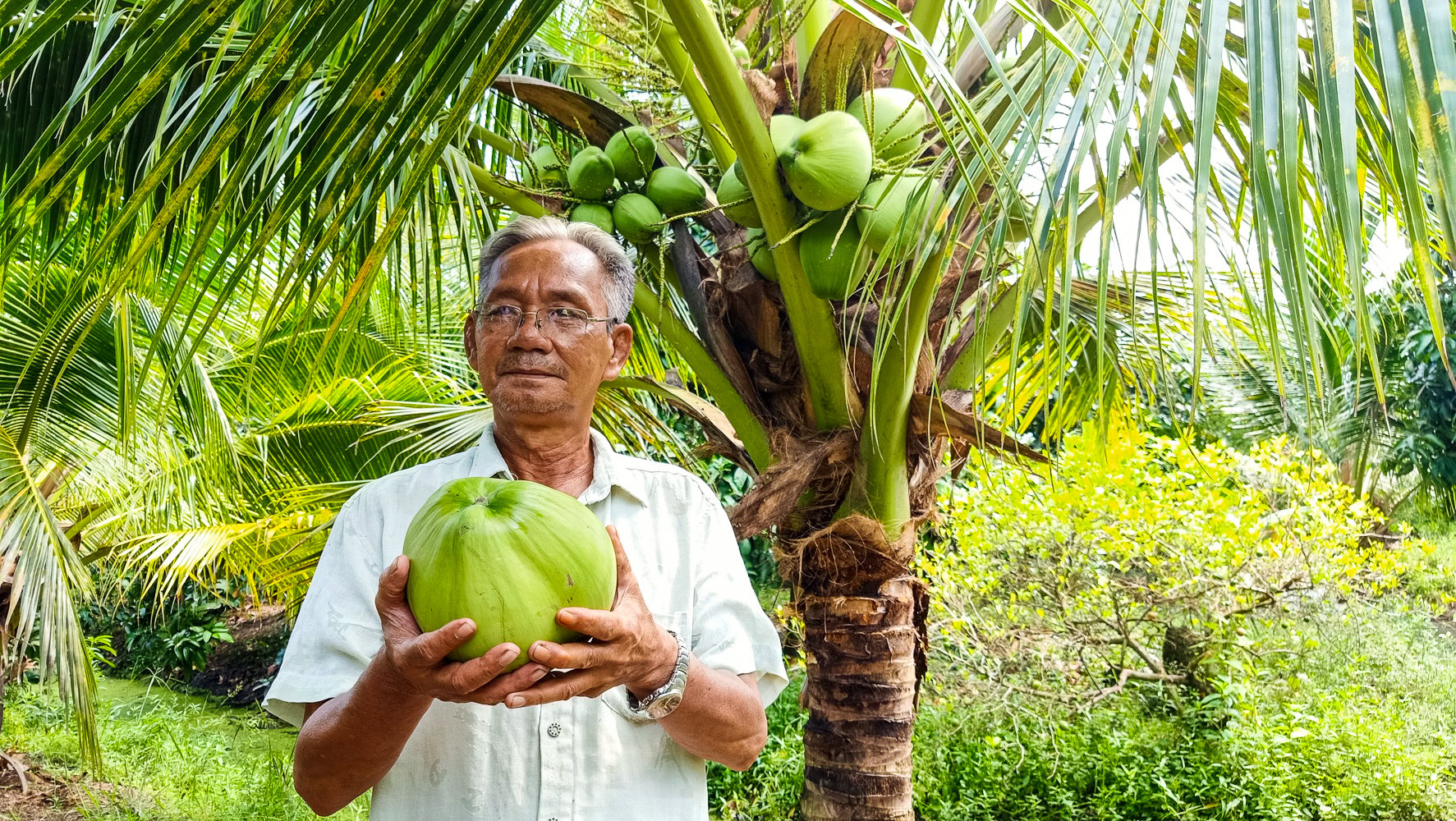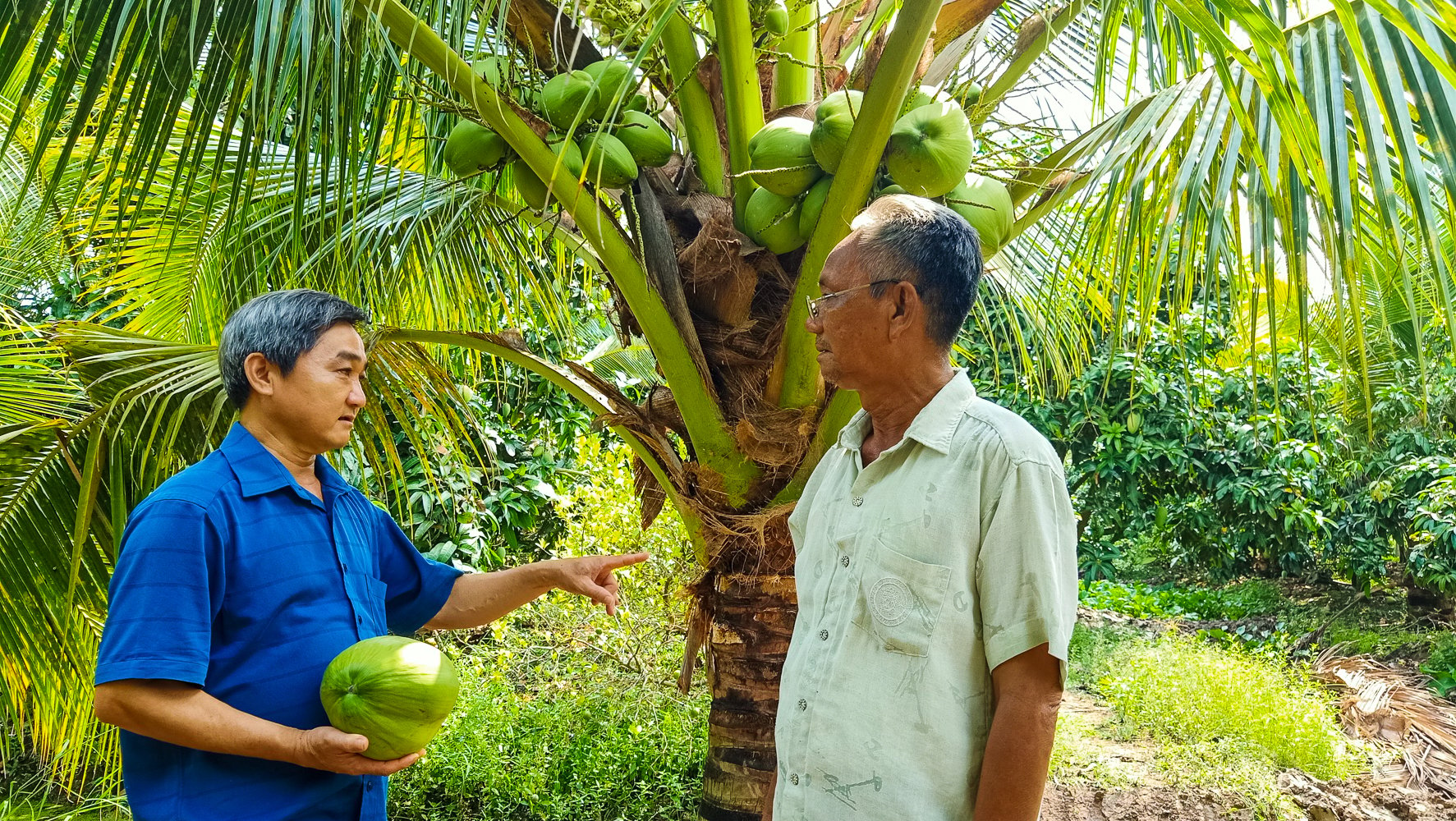May 20, 2025 | 03:22 GMT +7
May 20, 2025 | 03:22 GMT +7
Hotline: 0913.378.918
May 20, 2025 | 03:22 GMT +7
Hotline: 0913.378.918

The entire Soc Trang province currently has 8,500 hectares of fresh coconut growing, concentrated in the districts of Cu Lao Dung, Long Phu, Tran De, and Ke Sach. Photo: Kim Anh.
The province of Soc Trang is known for its significant cultivation of coconut, which is a prominent crop in the districts of Cu Lao Dung, Long Phu, Tran De, and Ke Sach. The total land area dedicated to coconut cultivation in these districts is around 8,500 hectares.
In these days, the main form of coconut consumption mostly involves traders or is limited to local regions, resulting in a relatively low economic value derived from coconuts. The agricultural sector of Soc Trang province has collaborated with localities to reestablish the entire production chain in response to the information received from the Plant Protection Department (MARD) regarding the field inspection conducted by the General Department of Customs of China on fresh coconut growing areas and packaging facilities. This initiative aims to enhance the competitiveness of exporting fresh coconuts to neighboring provinces and cities.
According to the Soc Trang Provincial Department of Crop Production and Plant Protection, there have been organized meetings with coconut export enterprises in the region, whereby guidance and training sessions were conducted for coconut farmers.
A coconut raw material area spanning over 33 hectares has been created in Phuoc Hoa A hamlet, located in Cu Lao Dung town, Cu Lao Dung district. The primary objective of this establishment is to cater to the export market, with particular emphasis on organic agricultural practices. Furthermore, in the course of the production process, gardeners diligently maintain comprehensive production records and organize them using different plans for each coconut garden, so facilitating the process of control and management.

Soc Trang Provincial Department of Crop Production and Plant Protection has sent a dossier to the Plant Protection Department (MARD) to consider and request the General Department of Customs of China to approve and grant 4 coconut growing area codes with an area of over 182 hectares in Cu Lao Dung district. Photo: Kim Anh.
The Van Thinh Phat Agricultural Cooperative, located in An Thanh 2 commune, Cu Lao Dung district, has expanded its coconut growing area by actively connecting an additional 35.5 hectares in Pham Thanh Hung B hamlet and 45 hectares in Binh Du A hamlet. This strategic move aims to enhance the cooperative's chances of obtaining a growing area code.
Furthermore, in order to maintain high standards of coconut quality with regard to pesticide residues, growers also use proactive steps to mitigate the occurrence of plant diseases. The primary approach is to provide emphasis on the utilization of organically derived pesticides. In order to mitigate the presence of beetles and black-headed worms, it is common practice to introduce parasitic wasps or employ pincers. Alternatively, the implementation of Integrated Pest Management techniques may be employed as a proactive strategy to prevent disease outbreaks. By adopting these strategies, one can adopt a passive approach towards the management of pests and diseases.
At present, the entirety of Soc Trang province has been allocated a total of 94 area codes for coconut cultivation. Based on the proposed strategy, the province intends to designate 4 - 10 supplementary planting area codes, spanning an area ranging from 200 to 350 hectares. The objective of this initiative is to provide the essential prerequisites for the successful exportation of the initial consignment of fresh coconuts to either the US or Chinese markets.
According to Mr. Nguyen Thanh Phuoc, the Director of the Department of Crop Production and Plant Protection of Soc Trang province, the formal exportation of fresh coconuts will serve as a catalyst for the establishment of further growing area codes in Soc Trang. By enhancing economic value, augmenting revenue, and fostering knowledge of sustainable agricultural practices among local gardeners, a competitive advantage may be established in the context of exporting.

The coconut growing area focuses on organic production in Ke Sach district, Soc Trang province. Photo: Kim Anh.
Mr. Phuoc suggests that gardeners should prioritize enhancing coconut gardens in the long run. This can be achieved through concentrated planting, enhancing the quality of coconut seedlings, and giving preference to the utilization of biological agents to maintain ecological equilibrium in cultivation regions, thereby effectively mitigating the spread of detrimental organisms. It is of utmost importance for gardeners to establish connections between communal production, form cooperatives, and integrate sustainability into the coconut industry chain, spanning from production to product consumption, with the aim of enhancing economic value.
At present, the Department of Crop Production and Plant Protection in Soc Trang province has submitted a formal document to the Plant Protection Department, (MARD). The purpose of this submission is to seek consideration and approval from the General Department of Customs in China for the allocation of four distinct area codes for coconut plantations. These area codes would cover a total land area of over 182 hectares, specifically located within the Cu Lao Dung district.
The agriculture sector of Soc Trang province is engaged in a collaborative effort with various firms to establish packaging facilities for the purpose of exporting fresh coconuts, therefore complementing the existing coconut-producing region that emphasizes organic production. This initiative aims to provide the necessary circumstances for facilitating the exportation of Soc Trang fresh coconuts.
Coconut in the nation encompasses around 188,000 hectares, with a notable concentration in the Mekong Delta provinces, including Ben Tre, Tra Vinh, Tien Giang, Vinh Long, and Soc Trang. In recent times, local authorities in the region have noted a notable emphasis on providing training programs to guide gardeners in cultivating coconuts in accordance with established standards such as VietGap, GlobalGap, and organic practices.
The Chinese market experiences an annual demand of over 2.6 billion fresh coconuts. However, the local supply capacity is only able to meet around 10% of this demand, resulting in a significant reliance on imports to fulfill the remaining need.
In Vietnam, the industrial production value of coconut goods amounts to over 3,300 billion VND per year, constituting more than 12% of the province's overall industrial production value.
Translated by Linh Linh
![Reducing emissions from rice fields: [Part 1] Farming clean rice together](https://t.ex-cdn.com/nongnghiepmoitruong.vn/608w/files/news/2025/05/05/z6509661417740_a647202949c539012a959e841c03e1d3-nongnghiep-143611.jpg)
(VAN) Growing clean rice helps reduce environmental pollution while increasing income, allowing farmers to feel secure in production and remain committed to their fields for the long term.
/2025/05/19/5136-1-144800_230.jpg)
(VAN) The Nghe An Provincial People's Committee has just approved the list of beneficiaries eligible for revenue from the Emission Reductions Payment Agreement (ERPA) in the North Central region for the year 2025.

(VAN) 14 out of 35 domesticated elephants in Dak Lak province have had their living conditions improved, with 11 of them currently participating in the non-riding elephant tourism model.

(VAN) Muong Nhe Nature Reserve hopes that being upgraded to a national park will lay the foundation for forest protection efforts to be carried out in a systematic, modern, and sustainable manner.
/2025/05/16/3923-2-171845_52.jpg)
(VAN) Lower costs, higher yields, and improved soil quality are outstanding benefits that soybeans bring when integrated into the crop rotation system.

(VAN) The 'For a Green National Environment' programme aims to promote a green lifestyle, support businesses in implementing ESG practices, and turn Net Zero commitments into concrete actions.

(VAN) Cold-barn systems efficiently manage environmental and temperature conditions, which aids in the prevention of respiratory diseases in pigs and protects them from the vectors that transmit African swine fevers.